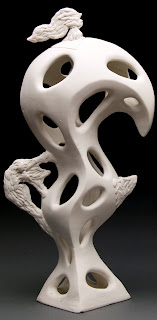
Pottery Vs. Ceramics
I was recently asked about the difference between pottery and ceramics. In my opinion, there is little difference except in application. Pottery is the physical thing, the functional produce of potters. Ceramics suggests more formal training, a higher use, a lovely work of art, and is also the produce of potters. However, this question was in regards to the cheerful ceramic clowns, bears, unicorns, and generally mass produced items made with clay slip and molds. In my opinion, those are not 'ceramics', though the label is loosely applied; those are 'figurines' or 'novelties' or 'tacky'. When I say "ceramics" and "pottery", I am usually referring to the hand-made pieces produced by individuals who have some type of experience with clay. The terms also apply to the work that was originally produced for farmers over a hundred years ago. Ceramics, and pottery, has evolved to a general broad acceptance amongst art collectors and general folk looking for something they can hold, daily creations that brighten their lives and enhance the mundane function of drinking morning coffee, eating a bowl of cereal, or pouring a cup of tea.
The Value of Ceramics, or, What Does Pottery Mean to Me?
Well, in Georgia, clay is already a part of everyday living. It gets stuck to our tires, plays havoc with our landscaping, and stains our skin and clothes in local man-made lakes or rivers. It gives the water around here that lovely color, and creates soft slippery pools for our bare feet. What is the value of local pottery? More than any monetary value you could place on it, local pottery is usually made with--wait for it--local clay. Each cup, plate, or hand-made ceramic sculpture you see at a local pottery show is literally a piece of Georgia. No matter the shape, no matter the glaze, this piece was once a part of the Georgia geography and has been formed and solidified into a shape that no longer suggests its geographical history. Georgia is hidden in each cup, and cradled by your hands each time you pick it up. We take from the land; the land nourishes us. I wonder if the potters of a hundred years gone felt the sense of connection with the land that you usually associate with those who work in agriculture.
What is the Appeal of Going to Pottery Shows
Fired Works, a Regional Ceramics Show and Sale (aka, Macon Art’s large pottery show) features 58 artists this year. The appeal, other than having the unique opportunity to see large amounts of artwork from each of these artists, is to remember they all start with the same basic material: clay. You find the same shapes throughout cultural history: the pot, the plate, the bowl, the cup. Cultures around the world found this malleable material and molded it into the same shapes, found the same purpose. It was used to create play things, to mold images of gods, and to capture the likeness of everyday people. The age old process has not changed, nor will it, since it was discovered. Historically speaking, this is the oldest true art form still in use today.
Fired Works: A Regional Ceramics Exhibit and Sale
We're on the cusp of Fired Works, and encourage you to see what all the fuss is about. We boast the largest collective ceramics show in the state: 58 ceramic artists agreed to participate, and we've shoved tables against the walls to make space for over 2,000 ceramic pieces. Fifty seven of our artists live in Georgia, and 12 of them are new to the event this year. Many participating potters do this as a full time job, but several are college professors, art teachers, and retirees. Young and old, our artists have found the same creative medium that connects them, and Macon Arts has that on display. This is art you can touch, hold, carry, cherish, and use everyday. Getting a hand-made ceramic piece connects you with the earth, with the history, and enriches your daily mundane with something unique.
Fired Works: A Regional Exhibit and Sale
April 18th through April 26th,
Daily Hours are 12 p.m. to 6 p.m.
Saturday from 10 a.m. to 5 p.m.
Sunday, 1 p.m. to 4 p.m.
Daily Tickets are $5, and you'll be able to use your stub to return throughout the week.
Our Preview Party is Friday, April 17th, from 6 p.m. to 9 p.m. Tickets are $25, and include appetizers, fresh grilled burgers, dessert, wine and beer, and live entertainment. You also have the first opportunity to browse and shop the show.














